|
|
|
|||
|
|
||||
|
|
||||
| The (Jet)X Files | ||||
|
|
HOME | SITE MAP | FORUM | CONTACT |
|
||
|
ABOUT | MOTORS | MODELS | ARCHIVE | HISTORY | STORE | FAQ | LINKS
|
|
|
|
|
|
||||||||||||||||||||||||||||||||||||||||||||
|
The (Jet)X Files 18
for June 2004
by Roger Simmonds Reprinted from SAM 35 Speaks, June 2004 Hunters, Gnats, Swifts and others No sooner had I written about the Skyleada Hawker Hunter in April’s article than Jason Willbourn sent me details of his revival of this early 1950s design, built exactly as Ray Booth’s plan, but for Rapier L2 HP power. Splendidly finished in bright red to match Neville Duke’s 1953 speed record holder, it weighs a little over 30g [right]. |
|
||||||||||||||||||||||||||||||||||||||||||||
|
My own version [below right] sports the pale green eau de nil of the first prototypes, and weighs 35g with noseweight. Unlike Jason, I took a few liberties with the design, sheeting the nose, wing roots, cockpit area and spine. I added an extra wing spar and webs and hinged the elevators and rudder. The building jig (copied from a Jetex ‘Tailored’ kit) facilitated accurate alignment of the flying surfaces. There is no dihedral, but I wasn’t brave enough to risk the true-scale anhedral. My modifications may raise questions about the propriety of desecrating period designs, but it is legitimate as long as the spirit of the original model is retained. Plans were not, after all, always copied slavishly at the time, but were then, and can be now, the starting point for one’s own unique creation (see later). [Another, larger illustration can be seen on Mike Stuart's flying scale model pages.] There are other reasons too, for modifying designs, some to do with ‘Health and Safety’. Howard Metcalfe’s KeilKraft Hunter (featured in (Jet)X Files, April 2003) was modified not only to improve its scale fidelity but also (note the diagonal wing ribs) its compatibility with Airspan, a modern iron-on (and non-toxic) covering material. Like Jason and Pete Smart, I think Hunters in camouflage look ‘naff’, and its shapely lines are so much better displayed by a uniform finish and without those awful ‘Sabrina’ excrescences. Incidentally, I used “Experts Choice” Clear Decal Film, for the markings, and was very pleased with the result. “Experts Choice” (available from Hannants in the UK) is compatible with domestic inkjet printers, enabling the squadron insignia, roundels etc., that we have so carefully computer manipulated to match our latest pride and joy to be conveniently printed at home. After sealing with clear dope or varnish they behave like any other waterslide transfer. The depth of colour, too, is realistic, preferable to many commercial decals which, whilst looking fine on paper, can appear all too bright in situ. Howard’s Hunter is a fine flier, but the KeilKraft design does have some puzzling scale anomalies, being different from both the Skyleada design and the full size Hunter prototypes. Pete Smart comments: “It should not be forgotten that there was a general lack of specific information at the time kits were produced. I think the KK Flying Scale range originated from photos rather than drawings. The really interesting one is of course the Hunter, which I believe flew before Hawker’s prototype. If you look at the wing roots, you will see they are modelled on the P. 1081, with a root rib parallel to the centre of the fuselage”. |
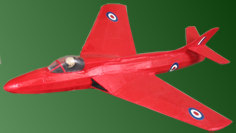
- photo by Jason P Willbourn
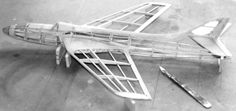 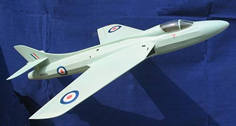 
- photos by Roger Simmonds
|
||||||||||||||||||||||||||||||||||||||||||||
|
“In fact”, Pete continues, “if you shorten the fuselage one bay in front of the wing and one bay behind and loose the spine you end up with quite a respectable P.1081”. He adds, tantalising, (as I’ve not seen it), “mine flew quite well”. These suggestions seemed well worth investigating. Reproduced on the right is a contemporaneous ‘three-view’ of the Hawker P.1081 taken from Jet Aircraft of the World by William Green and Roy Cross (1954). Below is the fuselage plan-view, and [right] a curious little drawing, from an original KK Flying Scale plan: 
The latter really does look like a P.1067/P.1081 chimera. I scanned the fuselage plan into a computer and manipulated the image as Pete suggested (using Paint Shop Pro), with the following result: |
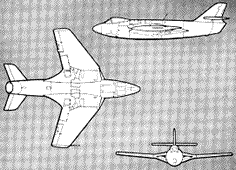
- Jet Aircraft of the World, 1954

- KeilKraft Flying Scale Jets
|
||||||||||||||||||||||||||||||||||||||||||||

I had to play with the shape of the canopy, fin and jetpipe shrouding, and modify the position of the tailplane, but we can see that Pete is right. The horizontal surfaces also need some reduction (they were much too large for the Hunter in any case), but the wings are actually spot on. It is, therefore, perfectly possible to produce a ‘period’ P.1081 plan (and perhaps, by an analogous transmutation, a P.1052 plan) from the classic P.1067 plan. This is very neat and most perspicacious of Pete. I hope Mr Hatfull would have approved. Though the Skyleada Hunter is a nice design and a fine basis for your own P.1083 (a supersonic Hunter derivative) others in the series are not as good. Pete Smart has this to say: “The early designs are definitely the best. Some of the later ones show a distinct ‘ham-fistedness’ as regards scale appearance and even the basic size of model. The one which makes me really cross is the Gnat, which has a huge square fuselage and yet is specified for the Jetex 50 or even Atom 35 … the angle of the motor has to be seen to be believed and makes you wonder if some models were even tested”. Ray Booth designed the Comet, MiG 15, Hunter, Swift, Canberra, Skyray, Cutlass, Javelin, Avro 707A and 698 Vulcan. These are all nicely drawn and competent designs; the Gnat, Jet Provost, YF-100 Super Sabre, Thunderjet, Venom and Mystère IV are by a different hand. Below is Ray Booth’s Hunter. 
And here is the Gnat Peter finds so offensive: 
The angle of the motor is indeed exaggerated, and since the motor is in front of the cg, this is equivalent to quite a bit of upthrust. Though the 12'' wingspan might appear reasonable, comparable to the Hunter (though remember that the Jetex Tailored Gnat is a mere 9¼" wingspan), the ‘full size’ Gnat was such a small aircraft that the 17.25" long fuselage is much bulkier in comparison to that of the Hunter. It would be interesting to know who was responsible for the Gnat, Venom, YF-100, etc. As can be seen from the example of the Gnat, the draughtsmanship of these models is somewhat inferior. Also, like the Gnat, they are really too large for their intended powerplants. |
|||||||||||||||||||||||||||||||||||||||||||||
|
On a happier note, the Vulcans (for Jetex 50 and 100) were justifiably popular in their day. Pete reminisces; “I must have been all of twelve when I built mine; it was never flown under power, but the sheer joy of gliding it down a slope is with me for ever”. He now has one that flies well with an L4. Jason Willbourn has recently made one for L2 HP power [right]. This is a really nice job and I hope he will soon tell me how he got on with trimming flights. The Skyleada range was, then, of variable quality (Pete remembers his amazement at finding a different cockpit canopy in every kit he opened) and overshadowed by their KeilKraft equivalents, which were more professionally presented and aggressively advertised. However, the range as a whole does not deserve the comparative neglect it has suffered and many designs are well worth recreating. One happy aspect of the plans, facilitating this, is that wing ribs, fuselage formers etc., are all depicted. |

- photo by Jason P. Willbourn
|
||||||||||||||||||||||||||||||||||||||||||||
|
As was promised last month, here is Chris Strachan’s new SAAB J-32 Lansen [right]. Whilst it is, of course, a modern design, the model is authentic ‘retro stick and tissue’ with several notable features such as a wing ‘D box’ reminiscent of Howard Boys’ 1947 Swallow (which Chris has also made for Rapier power) and through-ducting of air intakes to the Rapier trough, which I hope can be seen in the photo. Like many of these sorts of models, the fuselage is something of a stringerfest, but the result is well worth it. Chris, who prefers a traditional tissue and dope covering, has finished the Lansen in dark grey with spectacular fluorescent red flashes on the wings. He writes, “the wing span is 14.25" (equivalent to 1/36th scale), and it weighed 31.5g without motor. First glide tests indicated the need for 3g noseweight. There are interchangeable motor mounts so that it can take one or two L2’s”. [A larger illustration can be seen on Mike Stuart's flying scale model pages.] Opening up the scale air intakes and making paper ducts around the motor through to the trough allows the trough to be deepened; it also, says Chris, increases motor efficiency, changing the sound of the exhaust in an interesting way. It is well worth attempting with period designs, especially if the Jetex motor was originally left “hanging in the breeze”. This modification, far from being an act of desecration, enables the motor to be hidden better and allows the beauty implicit in a classic design to be revealed and more effectively displayed. There are those, of course, who will build a well-remembered model from their youth exactly as designed for nostalgic reasons. Andy Blackwell is making a KeilKraft P.1067 from a mint and original kit, unfortunately destroying it the process. The |
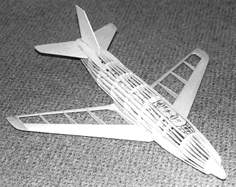
- photo by Roger Simmonds

- photo by Chris Strachan
|
||||||||||||||||||||||||||||||||||||||||||||
|
Andy has also been busy restoring his ‘Tailored’ Swift for the new season. Here is a picture [right] of the prototype (derived from a 1954 advertisement in Aeromodeller) to remind readers just what a lovely model it was, and what Andy is hoping to emulate. Andy’s model, rescued from being, it would appear, a child’s plaything, was last featured in the very first (Jet)X Files in January 2003. You will remember it was then in a very sorry state, with broken wings and tailplane mended with builder’s tape. It had been subjected not only to multiple coats of thick blue paint but also to the indignity of Japanese markings! It weighed 7½ oz. Andy has made new wings and tail, but the most arduous task was to remove the paint without destroying the delicate balsa fuselage shell. After some trials, Andy found Rustin’s ‘Strypit’ to be just the ticket, and was able to get down to the bare wood (and as he says, ‘sometimes beyond’) with wire wool and elbow grease. Rustin, by the way, make a dope thinner that smells evocatively of acetone and appears not to contain the more pernicious xylene. It mixes well and dries quickly; highly recommended. Lindsey Smith moulded a beautiful new canopy, and, with Starspan covering, (a most excellent polyester tissue, by the way, with good wet strength) the model weighs 4 oz with motor mount, which is about right. Andy will not decorate it until after its first flight (very wise), and I trust he will not fit the wheels included in the original kit (see advert). He is hoping to use one of his antique Jetmasters with original ICI fuel, though he does have the option of fitting a Jetex 200 if more ‘poke’ is required. Chris Strachan, who knew of the Jetmaster ‘Tailored’ models, but had not handled one in the flesh, remarked how large and impressive the Swift was, especially to someone used to L2 powered models. The Swift promises to be one of this year’s highlights at Old Warden. |
 Jetex ‘Tailored’ Swift
- Aeromodeller, 1954
|
||||||||||||||||||||||||||||||||||||||||||||
|
CO2 Rocket Motors We are nearing the end of our historical review of rocket propelled models. Many examples have been covered, from pre-war designs powered by squibs and skyrockets that can be authentically powered by Rapiers, to Jetex duration, sport, scale designs, (augmented or otherwise), ARTFs, helicopters and ballistic rockets. The adaptation of all of these to Rapier power has been considered. Judging from the letters, calls and emails I have received, I have stimulated some readers get back into the ‘smoky addiction’, as Stan Pearson calls it, which is most gratifying. There are still, however, some ‘jet’ types to review, for example catapult models and those energetically propelled by CO2 ‘Sparklet’ bulbs. These latter models, whether free flight or wire guided, were never as popular in the UK as they were in the US, where Cleveland models, Carl Goldberg, and others, produced some delightful models for “Jetex, catapult or CO2 power”. The advertisement [right] is taken from Model Airplane News (MAN) July 1948. Were these models available in the UK? I do not remember anybody flying CO2 rocket planes in my youth, though both ‘airplanes’ and hydroplanes were depicted in the US modelling books I borrowed from the library. I did not seek to emulate these examples. Tony Brookes featured a free flight rocket plane, the aptly named ‘Speedjet’, in one of his splendid ‘Green Bottles’ back in the eighties. This Vintage Design was first published in MAN, April 1950. 
Tony wrote; “Sleek and surprisingly modern in appearance, this model raises a great many questions, powered as it is by a free-standing Green Bottle with its seal pierced, used as a rocket. How this was to be done is not clear … nor are we told how to prevent liquid ejecting instead of gas. There is an implication – no more than that – that the cartridge is pierced in a charger and removing it whilst it is still full”. |
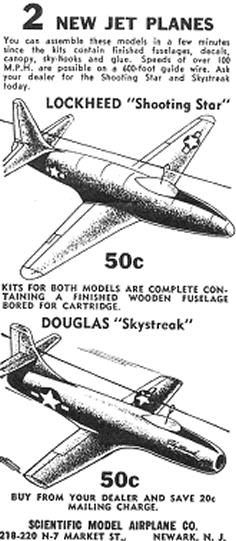 Scientific CO2-powered models
- Model Airplane News, July 1948
|
||||||||||||||||||||||||||||||||||||||||||||
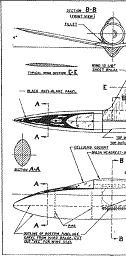
Has any reader any vintage tales of CO2 rocket planes? I know little about them; the period models sound very dangerous to me, so I want to leave a more extensive discussion of this genre until there is a commercial unit on the market which is safe and suitable for powering models originally designed for the smaller Jetex and Rapier units. Brian Eastwood did have a motor in development in the mid-nineties; others are now interested, and I have high hopes we will not have to wait too long. Scale Jet Trophy Tony Betts of Physics of Flight is planning a competition for the July meeting at Old Warden. His initial list of rules included:
|
|
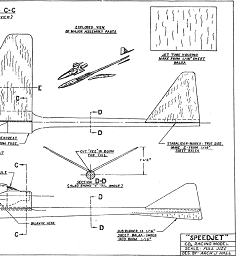
- Model Airplane News, April 1950
|
|||||||||||||||||||||||||||||||||||||||||||
|
|
|||||||||||||||||||||||||||||||||||||||||||||
|
|
|
||||||||||||||||||||||||||||||||||||||||||||
|
|
|
|
|
|
|
|
Acknowledgements - Article: Roger Simmonds - Illustrations: Roger Simmonds, Jason P. Willbourn, Chris Strachan |
|
|
|
|
ABOUT | MOTORS | MODELS | ARCHIVE | HISTORY | STORE | FAQ | LINKS |
|
|
Terms of Use
|
Queries? Corrections? Additions?
Please
contact us.
|
|